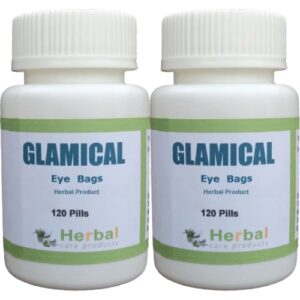Eye Health – Eye Exams, Vision Correction, Eye Diseases
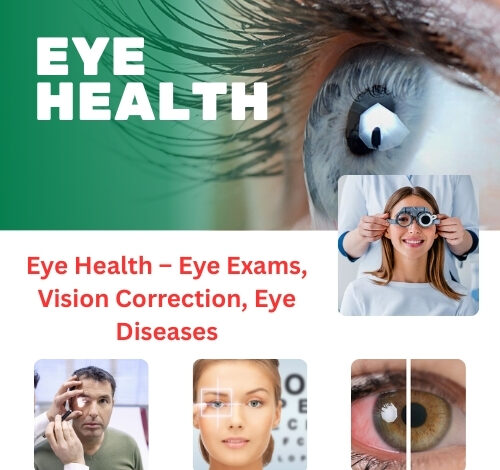
What is Eye Health?
Maintaining good eye health is essential for overall well-being, yet it is often overlooked until vision problems arise. Regular eye exams, proper vision correction methods, and an understanding of common eye diseases can help preserve eyesight and prevent complications. The importance of eye exams, different vision correction methods, prevalent eye diseases, and natural remedies like herbal supplements for eye bags and puffiness.
The Anatomy of the Eye
To fully grasp the importance of eye health, it’s essential to understand the basic anatomy of the eye. The eye is a complex organ consisting of various parts, each with a specific function:
- Cornea – The transparent front layer that helps focus light onto the retina.
- Iris – The colored part of the eye that controls the amount of light entering the eye.
- Pupil – The opening in the iris that regulates light intake.
- Lens – Helps focus light on the retina for clear vision.
- Retina – Contains photoreceptor cells that convert light into neural signals.
- Optic Nerve – Transmits visual information from the retina to the brain.
- Macula – A small central area of the retina responsible for sharp central vision.
Each component works together to produce clear and accurate vision. When any part of the eye is compromised, vision may be affected, leading to potential problems.
Importance of Eye Exams
Regular eye exams are a crucial aspect of eye health, as they help detect vision problems and underlying medical conditions early. Many eye diseases develop gradually and show no immediate symptoms, making routine check-ups essential for maintaining good vision.
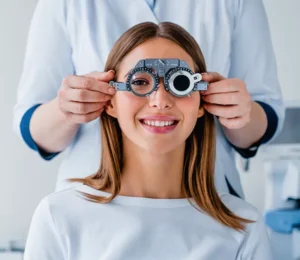
Types of Eye Exams
- Comprehensive Eye Exam: This includes tests for visual acuity, eye alignment, depth perception, and overall eye function. The doctor may also examine the retina and optic nerve to check for signs of disease.
- Refraction Test: Determines if a person needs prescription glasses or contact lenses.
- Tonometry: Measures intraocular pressure to detect glaucoma.
- Slit-lamp Exam: Examines the cornea, lens, and other eye structures for abnormalities.
- Retinal Imaging: Uses advanced imaging to detect issues like macular degeneration and diabetic retinopathy.
How Often Should You Get an Eye Exam?
- Children: Once before starting school, then every 1-2 years.
- Adults (18-40): Every 2-3 years unless advised otherwise.
- Adults (40-60): Every 2 years to check for age-related conditions.
- Seniors (60+): Annually, as risk for diseases like cataracts and glaucoma increases.
Vision Correction Methods
Poor vision can affect daily activities, leading to discomfort and reduced quality of life. Various vision correction options are available, depending on the severity and type of refractive error.
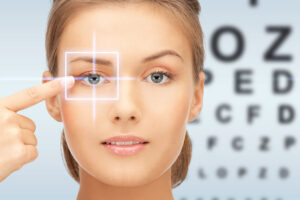
Glasses and Contact Lenses
Eyeglasses and contact lenses are the most common vision correction methods.
- Glasses: Available in different lens types such as single-vision, bifocals, trifocals, and progressive lenses.
- Contact Lenses: Options include soft lenses, rigid gas permeable lenses, toric lenses (for astigmatism), and multifocal lenses.
Refractive Surgery
For those looking for a permanent solution, refractive surgery offers several options:
- LASIK (Laser-Assisted In Situ Keratomileusis): Reshapes the cornea to correct nearsightedness, farsightedness, and astigmatism.
- PRK (Photorefractive Keratectomy): Similar to LASIK but removes the outer corneal layer instead of creating a flap.
- SMILE (Small Incision Lenticule Extraction): A minimally invasive laser procedure for correcting myopia.
- Implantable Lenses: Used for extreme refractive errors where LASIK is not suitable.
Natural Methods for Eye Health
While vision correction methods provide clear eyesight, incorporating natural approaches can also support eye health:
- Balanced Diet: Consuming foods rich in vitamins A, C, and E, along with omega-3 fatty acids, supports vision.
- Regular Exercise: Helps improve circulation and reduces the risk of conditions like diabetes that impact eyesight.
- Proper Hydration: Prevents dry eyes and irritation.
- Adequate Sleep: Reduces strain and fatigue, preventing puffiness and eye bags.
Common Eye Diseases and Prevention
Several conditions can affect eye health, ranging from mild discomfort to severe visual impairment. Some of the most common eye disorders include:
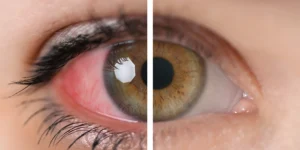
1. Refractive Errors
Refractive errors occur when the eye cannot properly focus light on the retina, leading to blurred vision. These include:
- Myopia (Nearsightedness) – Difficulty seeing distant objects.
- Hyperopia (Farsightedness) – Difficulty seeing nearby objects.
- Astigmatism – Irregular curvature of the cornea leading to distorted vision.
- Presbyopia – Age-related loss of near vision.
2. Cataracts
Cataracts occur when the eye’s natural lens becomes cloudy, leading to blurry vision, light sensitivity, and difficulty seeing at night. Cataracts are most commonly associated with aging but can also result from injury or medical conditions like diabetes.
3. Glaucoma
Glaucoma is a group of diseases that damage the optic nerve, often due to increased intraocular pressure. If left untreated, glaucoma can lead to permanent vision loss. It is often asymptomatic in its early stages, making regular eye exams crucial.
4. Age-Related Macular Degeneration (AMD)
AMD affects the macula, the part of the retina responsible for central vision. It is a leading cause of vision loss in older adults and can be classified as either dry (gradual vision loss) or wet (rapid vision loss due to abnormal blood vessel growth).
5. Diabetic Retinopathy
This condition results from high blood sugar levels damaging the blood vessels in the retina, leading to vision loss. It is a common complication of diabetes and can be managed through proper blood sugar control and regular eye checkups.
6. Dry Eye Syndrome
Dry eye occurs when the eyes do not produce enough tears or when tears evaporate too quickly. Symptoms include redness, irritation, burning, and blurry vision. Causes range from environmental factors to underlying medical conditions.
7. Retinal Detachment
Retinal detachment occurs when the retina separates from its underlying tissue, leading to sudden vision loss. Symptoms include floaters, flashes of light, and a shadow over the field of vision. It is a medical emergency that requires immediate treatment.
Herbal Supplements for Eye Health
Many people seek natural solutions to improve eye health and reduce eye-related issues, such as puffiness and bags. Herbal supplements for eye bags and puffiness offer a natural way to enhance eye appearance and health.
Best Herbal Supplements for Eye Bags and Puffiness
- Green Tea Extract: Contains antioxidants that reduce inflammation and swelling around the eyes.
- Bilberry Extract: Supports blood circulation in the eyes and reduces dark circles.
- Grape Seed Extract: Contains flavonoids that strengthen blood vessels and improve skin elasticity.
- Chamomile Extract: Reduces puffiness and soothes eye irritation.
- Aloe Vera Gel: Hydrates and reduces under-eye swelling.
- Cucumber Extract: Naturally cools and de-puffs the eyes.
How to Use Herbal Supplements Effectively
- Topical Application: Some extracts can be applied directly to the under-eye area.
- Oral Supplements: Taking herbal capsules or teas can provide internal benefits.
- Eye Compress: Applying soaked tea bags or herbal-infused pads to the eyes helps reduce puffiness.
Lifestyle Tips for Better Eye Health
- Reduce Screen Time: Follow the 20-20-20 rule—every 20 minutes, look at something 20 feet away for 20 seconds.
- Wear Sunglasses: Protect your eyes from harmful UV rays.
- Stay Hydrated: Drink plenty of water to prevent dryness.
- Manage Stress: Reducing stress levels helps prevent eye strain and puffiness.
- Get Enough Sleep: Lack of sleep can cause dark circles and worsen eye health.
Conclusion
Maintaining good eye health requires a combination of regular eye exams, appropriate vision correction, and lifestyle modifications. Understanding common eye diseases and taking preventive steps can help protect your vision for years to come. Additionally, incorporating herbal supplements for eye bags and puffiness can enhance eye appearance while supporting overall eye function. By adopting a holistic approach to eye health, you can ensure clear vision and a healthy lifestyle.

